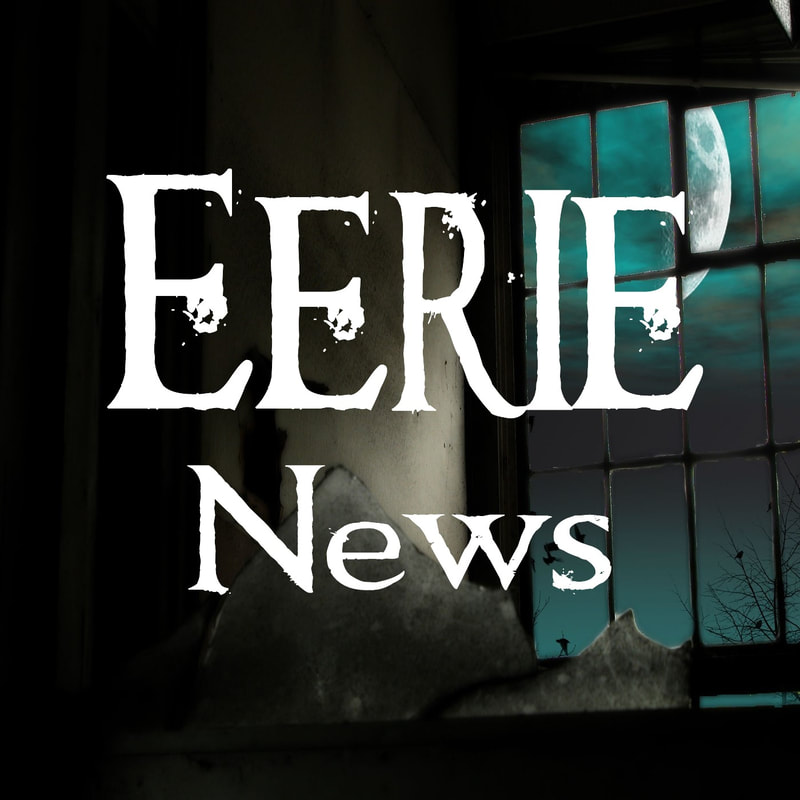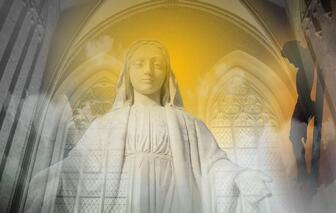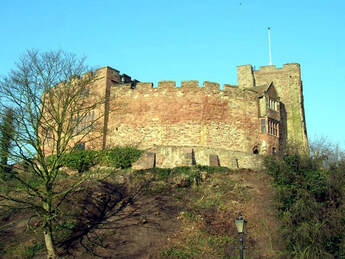 By M.P. Pellicer | Stranger Than Fiction Stories Tamworth has many ghosts that are said to be haunting it's ancient walls, but two of the most famous are the Black Lady and the White Lady. 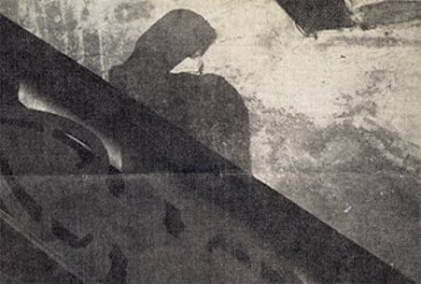 Picture of the Black Lady of Tamworth c.1949 Picture of the Black Lady of Tamworth c.1949 Tamworth Castle is of Norman mote & bailey design with a shell keep. The present stone structure replaced the first timber tower surrounded by a palisade, which was built shortly after the Norman Conquest in 1066. The land of the former Saxon burgh was given to Robert de Despencer by William, and it subsequently passed through marriage into the Marmion family. Numerous additions and alterations were made to the castle by succeeding generations of owners, until the late 1890's, when Marquis Townshend decided to sell the Castle by auction. The Marmions held the castle for over 100 years up until 1291, when Philip Marmion died with no heirs. In 1423, the castle passed on to Sir Thomas Ferrers of Groby. Then in 1688, the castle passed onto the Shirleys of Chartley through marriage. The Earls of Northampton then held the castle from 1715, and the Townshends of Raynham owned the castle in 1751. The castle was then purchased by the Tamworth Corporation for £3000, and it was opened to the public to visit in 1899. It is not surprising that Tamworth Castle is reputedly the home of many ghosts and spirits that are regularly seen, or their presence felt within it's walls and grounds. In 1999, Ann an employee at the castle claimed that not a day went by without her experiencing something she couldn't explain. Once she was called out to the castle late at night, after the wind had set off the castle alarm system. The police had been called to make sure the castle had not been broken in to. Ann waited in the reception for the engineer to come and reset the alarm. After half an hour Ann became aware of the sounds of footstep from the room above her, then other noises became audible. She described it to a local newspaper this way: It sounded like some of the heavy furniture in the room upstairs scrapping across the floor. I wasn't immediately bothered by it all until suddenly this aura came all over me, and I instantly felt an overwhelming presence. Though most of us here at the Castle feel some kind of unexplained presence almost on a daily basis, this was far different to anything before. For the first time ever I felt as though I wasn't supposed to be in the building. 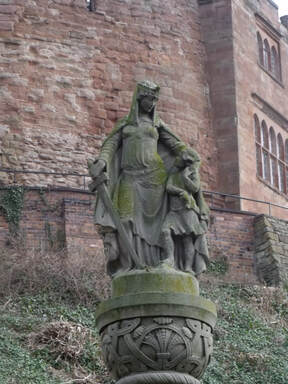 Statue of Aethelflaed (Ethelflaed) ‘Lady of the Mercians’ died at Tamworth Castle in 918 Statue of Aethelflaed (Ethelflaed) ‘Lady of the Mercians’ died at Tamworth Castle in 918 Ann then ran out the front door and straight into the engineer, who seemed startled to see her. What he said next made a shiver run down her spine. Though he was expecting to be met by someone, he was shocked to see me. Puzzled, I asked why, and he said while walking up the castle path only moments before he saw someone looking out of a window. He said he simply waved and the `person' stepped back into the darkness. But it wasn't me, that's for sure. I'd waited on the ground floor and by the time he saw the image, I was running outside. When I asked him to point to the window in question, he indicated the Ferrers Room, which is the one where all the noises had come from. This was used as the curator's office, and had recently had a circular meeting table and chair brought in. Was the ghost upset because they were modern, and didn't fit in with the look of the castle? June Hall, another long standing member of staff recalled opening up one morning with a colleague, Val Lee, and walked into the room which houses the Tamworth Story exhibition. "I was struck in the face and momentarily blinded. It felt like sand had been thrown at me. When Val came in behind me, I was bent over trying to clear my eyes and shaking my top. Then Val and me saw a blue mist swirl around the room and out of the window." 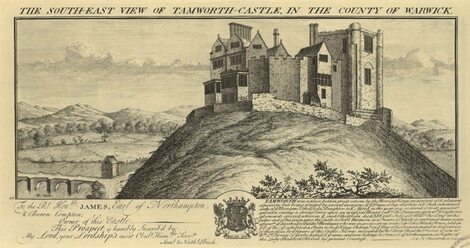 View of Tamworth Castle c.1700s View of Tamworth Castle c.1700s The year was 925, when Athelstane the King of Mercia gave his daughter Editha in marriage to Sigtrygg or Jarl of Northumbria, a Norse ruler. The marriage was meant to cement peace, since 50 years earlier the Danes had ransacked the town. The capital of Mercia was Tamworth. Editha refused to marry Jarl unless he became a Christian. History is not clear whether Sigtrygg reneged on the agreement to convert or deserted Editha, but it resulted in Editha joining a convent at Polesworth. She became Abbess of Tamworth and died in 960. Three years later the Danes invaded once more, and King Edgar of England had to rebuild Tamworth. It was then that Editha was canonized as a saint, and the town's church was dedicated to her. In the years after Editha's death, Mercia failed and William the Conqueror invaded England. He granted Tamworth and its lands to Robert de Despencer, who died with no male heir. It was either passed onto a daughter or a niece who married into the Marmion family. Marmion seized Editha's old convent, and then returned it to the Church. The reason supposedly that he became so generous, is that Marmion had been hunting in Hopwas Wood. He stopped to rest, and while napping he dreamt that Editha struck him with her crozier of office, making a wound. When he woke up he was badly wounded, and as the days passed it refused to heal. He interpreted this event to indicate the nunnery was to be returned to the Benedictine nuns, who went on to build a new convent. Editha is supposed to be the Black Lady of Tamworth, and the reason for her haunting is unknown. One could question however, if the nuns had been restored to the Convent, would St. Editha still haunt the castle? Could it be because the Abbey was voluntarily surrendered by the Abbess Alice Fitz-Herbert to the crown in 1539, under the reforms of church and state during the reign of Henry VIII? 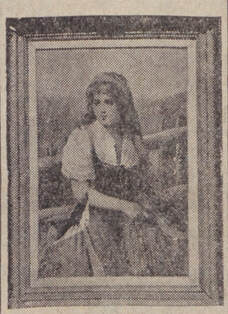 The Gleaner was a painting that was vandalized in Tamworth Castle in 1949 by an unknown person. The Gleaner was a painting that was vandalized in Tamworth Castle in 1949 by an unknown person. The Black Lady was once again recorded in 1949, when a team of ghost hunters carried out an overnight vigil at the castle. Just after the stroke of midnight, following noises on the staircase, a photograph was taken. When developed, the picture showed a shadowy hooded figure descending the stairs. That same year an unknown perpetrator slashed and punctured four of the twenty canvasses in the art gallery. It occurred on a Sunday, and since the castle was not adequately staffed, no one saw or heard anything. The culprit was never found. 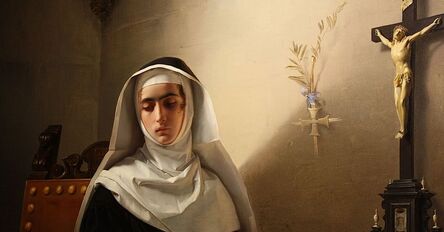 Edith, Abbess of Tamworth is purported to be the Black Lady of Tamworth Edith, Abbess of Tamworth is purported to be the Black Lady of Tamworth The other ghost at Tamworth is The White Lady. She is said to have been captured and locked in the Tower by the wicked Sir Tarquin. But after a while she fell in love with him and is said to walk the battlements around the castle, weeping over her lover who was slain by Sir Lancelot du Lac, who came to rescue her. Legend has it that the White Lady threw herself from the battlements when she found that Sir Tarquin was dead. Her ghost has been seen walking the battlements, and on the Warwickshire moors within sight of the castle.. This tale is included in the Arthurian legends re-written in the Middle Ages, but does not mention the site of Tarquin`s castle, where Sir Gawain and other knights had been held captive until they were freed by Lancelot.
0 Comments
Your comment will be posted after it is approved.
Leave a Reply. |
Stranger Than Fiction StoriesM.P. PellicerAuthor, Narrator and Producer Archives
July 2024
Categories
All
|
Stories of the Supernatural
- Stories of the Supernatural
- Miami Ghost Chronicles
- M.P. Pellicer | Author
- Stranger Than Fiction Stories
- Eerie News
- Supernatural Storytime
-
Astrology Today
- Tarot
- Horoscope
- Zodiac
-
Haunted Places
- Animal Hauntings
- Belleview Biltmore Hotel
- Bobby Mackey's Honky Tonk
- Brookdale Lodge
- Chacachacare Island
- Coral Castle
- Drayton Hall Plantation
- Jonathan Dickinson State Park
- Kreischer Mansion
- Miami Biltmore Hotel
- Miami Forgotten Properties
- Myrtles Plantation
- Pinewood Cemetery
- Rolling Hills Asylum
- St. Ann's Retreat
- Stranahan Cromartie House
- The Devil Tree
- Trans-Allegheny Lunatic Asylum
- West Virginia Penitentiary
- Paranormal Podcasts
"When misguided public opinion honors what is despicable and despises what is honorable, punishes virtue and rewards vice, encourages what is harmful and discourages what is useful, applauds falsehood and smothers truth under indifference or insult, a nation turns its back on progress and can be restored only by the terrible lessons of catastrophe."
- Frederic Bastiat
- Frederic Bastiat

Copyright © 2009-2024 Eleventh Hour LLC. All Rights Reserved ®
DISCLAIMER
DISCLAIMER
 RSS Feed
RSS Feed





